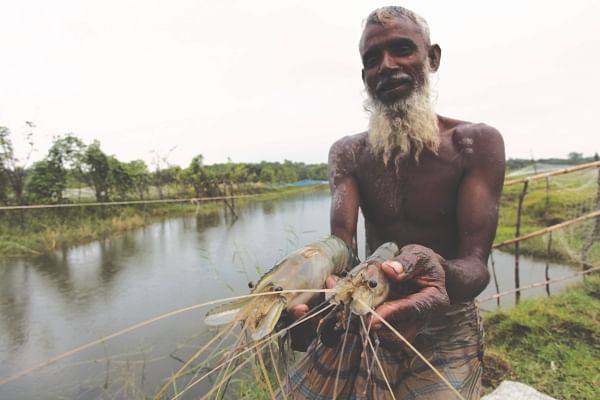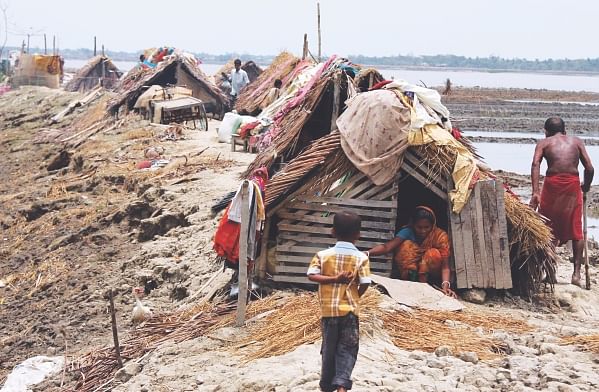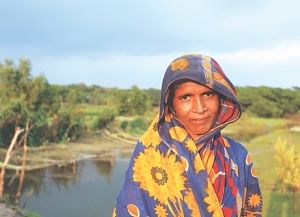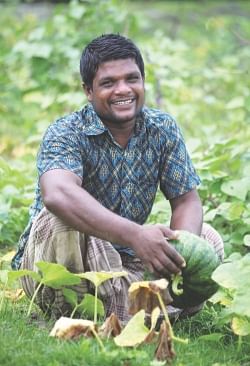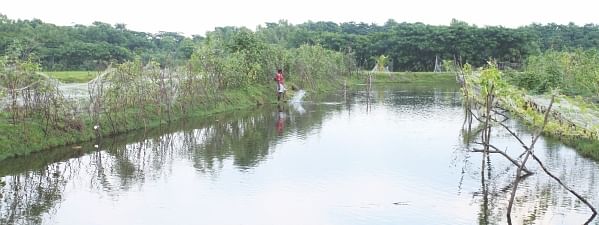| Home - Back Issues - The Team - Contact Us |
 |
| Volume 11 |Issue 41| October 19, 2012 | |
|
|
Special Feature Rising from Barren Lands Coastal communities are hardest hit when natural disasters such as cyclones and floods visit Bangladesh's shores. An innovative pilot project is in its final six months of working to create alternative livelihoods for landless people and protecting the environment from future natural catastrophes. the Star's SORAYA AUER visited the initiative, which recently won an international award, in the coastal district of Barguna.
As an orange sun sets over the top of a mangrove forest, Hamida Begum, from Sonatala village, points to her stomach and says, “We do what we do because of this – hunger and poverty, understand? There was a time when we didn't know when our next meal would come but through this, we know we can eat and our other needs are guaranteed to be met.” Hamida is referring to the ditch and dyke provided to her and her husband through the Community-based Adaptation to Climate Change through Coastal Afforestation project, an $8 million joint initiative by the Bangladesh government and United Nations Development Programme (UNDP). Since 2009, the pilot project has given almost 1,000 landless people in coastal districts access to otherwise unusable government lands to grow fruit, vegetables and fish. It has also attempted to reduce greenhouse gases and protect the land and people from further storms and erosion by planting new mangrove species along the coast. Dr Paramesh Nandy, project manager of the initiative, explains, “There was nothing here before. Hundreds of hectares of land lying in between the mangrove forest and the embankment has been lying barren for years and years and is supposed to be encroached on in the future. Due to periodic inundation, it was not possible to grow anything here. To prevent people from encroaching on the forest for resources, we made this vertical use of the land, because horizontal was not possible.”
The project, which is the first of its kind in Bangladesh, has built eight ditches and dykes in every hectare of previously unusable land, so that fruit, vegetables and timber trees can be grown on the mound while fish can be cultivated in fresh water ponds. This is part of a new land use model called 'Forest Fruit Fish', or 'Triple F Model' in NGO jargon. “We are giving them high-yielding varieties of fish and crops, like fruits, available in Bangladesh,” says Dr Nandy proudly. “On this 3m wide 60m long mound they can produce short-term vegetables for their own household consumption as well as for selling. You will find here many people who have already earned Tk 15-20,000 from only selling vegetables. Many have earned more than Tk 20,000 from selling fish within six months and are expecting Tk 50,000 within one year.” The project's manager adds, “This is huge income, and this is our main objective – to let them generate resources themselves.”
There are currently 80 beneficiary families, including Hamida's, at the project's site in Naltona Union in Barguna Sadar Upazila. The Agriculture, Fishery, Livestock and Forestry departments have committed to provide their respective training and even supplying machinery and resources when required. “The input of the villagers is just their labour,” insists Dr Nandy as he stands by one of the fresh water ponds as fish are being fed. “They are getting everything from the project, like training and all the input so that they are encouraged. This is just the first year, so next year, they will be able to provide for themselves.”
Hasan Garon used to sell his labour as a fisherman on big boats during the fishing seasons to support his family. “When I used to be a fisherman on the rivers, it's not like I was out there all the time. I used to come home, sit and do nothing. Now when I come back, I maintain this ditch and dyke and this helps me earn extra money.” The 29-year-old says he used to grow trees but most of them died. “I grow korolla, mishty kumra, chal kumra, jali kumra, lau, shim, and different types of fish – rui, katla, silver cup and telapiya.” He has already earned Tk 25,000 from selling fish and vegetables and expects to double this by the end of the Bengali year. Shaheena Akther, who supports a sick husband and three daughters, is one of the 42 percent of women beneficiaries. She says, “I was able to make Tk 12,000 from just selling the vegetables on my scaffolding and around Tk 10,000 from other vegetables and fruits after taking what I needed for my own family. I'm expecting to make Tk 40,000-50,000 from selling the fish at the end of the year.” Shaheena is a good example of how the project has the potential to alleviate poverty while not acting like a relief handout. As she cuts the grass around her fresh water pond she says, “The project is really benefiting my family because I don't have to buy fish and vegetables for my family's needs and with the money I earn from selling the rest, I can buy medicines and afford my children's education fees.” Growing fish in a sweet water pond is nothing new to Safiya Begum. The widow dressed in a black burqa says, “I had a pond by my house where I used to have fish before I was given this ditch and dyke. It wasn't at all as big, but it worked out well as a small source of income.” As her eight-year-old granddaughter stands shyly behind her, Safiya recalls, “Cyclone Sidr flooded my entire village and I couldn't find any more fish in my pond. I am hopeful that with the money I get from this project's pond, I will recoup all my losses from previous years.” While optimism is in everyone's words, the villagers say there have been unforeseen bumps in the project's road to success. Theft is one of them. “Our first year was good but we couldn't sell too much fish because many were stolen,” explains Safiya. “Everyone is suffering from this, people stealing our fish. Last year I could only sell Tk 500 of fish because that's all there was left.” Dr Nandy explains, “Initially we did not think of this [theft] but once it happened here, the farmers gathered in presence of the UNO [Upazilla Nirbahi Officer] all 80 beneficiaries and had elections to make a farmers' association. Now once every 80 days, one member will be responsible for guarding this area.” Crops and fish were stolen, but the birth of this farmers' association is a blessing in disguise for the Ministry of Forest and Environment according to Dr Nandy. “In Bangladesh currently, one forest guard is responsible for looking after more than 1,500 hectares which is just not possible. We are providing eight beneficiaries per hectare who will alert the forestry department of any illegal activities happening within the forest, which means coastal communities are taking a voluntary role to protect the coastal forests. They are strengthening the monitoring capacity of the forest department,” concludes Dr Nandy. However, another uncontrollable and foreseeable danger, with no silver lining, is future natural disasters. The planting of mangrove species which can take the brunt of most storms (as seen in last Thursday's storm in Noakhali coastal areas where a belt of trees were uprooted or broken while homes remained intact) certainly helps but even the raised nature of the ditches and dykes cannot always withstand salt water floods. “Two months ago, there was a hole under this road where all my fresh water and fish got out,” remembers Hasan. “I'm afraid that because this place is surrounded by the river, if a major disaster hits, it'll ruin the whole project but if the government helps us to fix the road next to the project, it could help save us from a lot of natural disasters.” He adds, “If another cyclone hits, it's going to be a huge loss because we could get a lot of money by selling the fish this year.” Dr Nandy hopes, however, that the people will solve their own problems in time without further help from the project or government. “Within two years, they will earn such money that they will be able to replace everything themselves, no need to get help from anyone else. That is the philosophy: let them make themselves self-sufficient so they can do this by themselves.” While this would be ideal, many of the beneficiaries have other debts to pay before they can think to save. “I don't have any savings. We are four brothers and two sisters. Two of my brothers are in Pathorghata and I share their education costs with my father. We had a loan from Grameen Bank so that we could marry our sisters two years ago and I still owe Tk 25,000. I have to pay back Tk 550 a week.” Shaheena shares similar woes, “I had to sell my cows and borrow money from my father to pay for my husband's treatment and I still owe various people Tk 25,000. If I could grow the fish in my pond bigger, I could pay off my debts.” For most, a lot is riding on the fruits of their labour being successfully sold in the coming months. Shaheena believes the opportunity has been a blessing but is conscious of the rift it has created between neighbours. “There are people who weren't included in the project and they create a little bit of a problem. People who can afford their children's education and food have been getting dykes and those who can't afford to eat twice a day or own land have been given nothing.” The local Chairman of Naltona Union Parishad, Muhammad Shafiquzzaman, insists however, the selection process to choose which coastal villagers would profit from the project was fair and impartial. He says, “One hundred percent impartial. Even if my father came to me asking for a piece in the project, I would've told him no.”
Dr Nandy also points out how some villagers were not initially happy to work at half rate labour prices in exchange for a part of the project and are perhaps regretting that decision. “He who cares about his crops, reaps the benefits and now others are motivated,” he says positively. “There have been instances where people were not active enough so the responsibility of maintaining a ditch and dyke was given to a new beneficiary instead.” The project's nature of providing land, resources and training is an unusual but welcome treasure for coastal communities so undoubtedly the opportunity will continue to be desired by those not yet involved. Assuming that those who deserve this alternative livelihood are given it and natural disasters are successfully kept at bay by the mangrove forests and raised lands, replicating this innovative project to reach the thousands more coastal people in need of assistance will not only be a life changing prospect but also a back-slapping worthy moment for the government, UNDP and project organisers. For someone like Hamida, who has probably had to worry about survival all her life, she can rest easy knowing that thanks to the project, she doesn't have to worry about the next meal.
|
||||||||
Copyright
(R) thedailystar.net 2012 |
